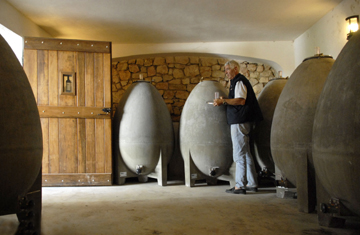
Ready to hatch The cellar at Domaine de Lauzières in Provence
Nestled among rolling hills and olive groves once painted by Van Gogh, Domaine de Lauzières appears to be your quintessential Provençal vineyard — until you step into a peculiar cellar. There are no barrels to be seen, nor any of the stainless-steel tanks favored by some modern vintners. Instead, winemaker Jean-Daniel Schlaepfer ferments his high-end wines there in egg-shaped vessels based on amphorae — the clay jars used by the Romans centuries ago. Schlaepfer is part of a growing group of producers around France and beyond returning to the wisdom of the ancients in order to achieve the truest expression of a given harvest.
The modern version of the amphora, a tank known colloquially as the Nomblot Egg, was created in 2001 by French vatmaker Marc Nomblot. He was following a whimsical request by Rhône winemaking powerhouse Michel Chapoutier, whose appreciation for harmonious, natural shapes complemented his holistic and organic methods of viticulture. The Egg might have remained a conversation piece in Chapoutier's cellar if word hadn't reached Baux-de-Provence, a progressive appellation where nearly all vines are farmed organically. There, Schlaepfer and partner François Pillon saw a resemblance between the Egg and the dolia, or the large amphorae used to make ancient Rome's most renowned wine, Falernum.
Vinifying in oak can produce woody, toasty or vanillin aromas that are not desirable in every case. Making wine in stainless steel, meanwhile, can deprive it of the bouquet and tannin-ameliorating effects of a measured oxygen exposure, sometimes obliging winemakers to use artificial micro-oxygenation. The Nomblot Egg's porous clay-cement walls offer a third way, allowing for natural oxygenation without oakiness. But the tank's most surprising benefit may well lie in its shape. Creator Nomblot explains: "All fluids rise when temperature increases, and do so in a vortex, but in a barrel or other container, the vortex is slowed by the angles," he says. Within the angle-free Egg, however, "the vortex turns naturally for weeks, which raises the lees, and nourishes the wine." It also eliminates the need for stirring, which is a common source of contamination from brettanomyces — yeast that leads to spoilage and cloudiness. "We used to break our backs racking and stirring the wine, and here's a system that works better than man," says Schlaepfer. "It's a magical vinification instrument."
The proof, of course, is in the tasting — while Roman procurator turned philosopher Pliny the Elder's maxim "in vino veritas" is atrociously overquoted, perhaps an exception can be made in this case. After several trial vintages at Lauzières, and by Schlaepfer's colleagues Christian Zündel in Switzerland and Dominique Hauvette in Baux, the verdict is in: greater minerality, fruitiness and elegance. Schlaepfer's white cuvée Astérie exhibits rich honey and exotic-fruit flavors; his Petit Verdot-dominant cuvée Sine Nomine is redolent with the complex bouquet of blackberry and cedar.
The Nomblot Egg has since been hatching in wineries all over the world, from Domaine Combier of Crozes Hermitage and Château de Fieuzal of Pessac Léognan to California and Australia. "It's a snowball effect," says Nomblot, who now sells 250 tanks a year. "My challenge is to convince the best winemakers in every country to use them." He speaks by phone from Chile, where his Eggs will soon be bubbling with Carménère at Alvaro Espinoza's celebrated Antiyal winery.
Back in Europe, a handful of winemakers have taken the Roman revival to the next level. In the southern Rhône, Philippe Viret had an epiphanic moment several years ago when tasting the cuvée Pithos by Azienda Agricola Cos — a star vineyard in the current Sicilian wine renaissance that ferments Frappato in simple terra-cotta amphorae. Joining with an artisan potter in 2007, Viret now creates an amphora-fermented Mourvèdre assemblage, with Muscat Petit Grain and Clairette Rose cuvées to come. He vaunts the gentle, low temperatures of fermentation in clay and its substantial porosity. Rather aptly, Domaine Viret is situated on a former Roman military camp.
Viret's search for an oak alternative began, like Schlaepfer's, from a desire to create wines as honest as they are incomparable. "It's not about making wine better than my neighbors; it's about making wines with a very strong identity," he says. "And I don't want to mask this identity — the minerality of my soil, the purity of my fruit — with artifice." Surely Pliny himself would see the truth in that.
Got an awful travel gripe? The Avenger may be able to sort it out for you.
